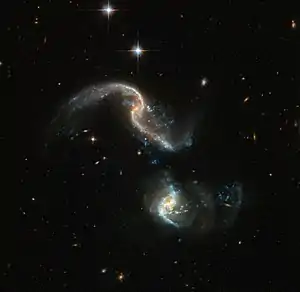| Arp 256 | |
|---|---|
 Image taken by Hubble Space Telescope. | |
| Observation data (J2000 epoch) | |
| Constellation | Cetus |
| Right ascension | 00h 18m 50.898s[1] |
| Declination | −10° 22′ 36.49″[1] |
| Redshift | 0.027[1] |
| Heliocentric radial velocity | 7985 km/s[1] |
| Distance | 380 Mly (115 Mpc)[2] |
| Apparent magnitude (V) | S: 14.33[1] N: 13.60[1] |
| Apparent magnitude (B) | S: 14.81[1] N: 13[1] |
| Characteristics | |
| Type | S: SB(s)b pec?[2] N: SB(s)c pec[2] |
| Apparent size (V) | S: 1.1′ × 0.6′[3] N: 1.1′ × 0.8′[4] |
| Notable features | Interacting galaxies |
| Other designations | |
| Arp 256S: MCG-02-01-051, PGC 1224[1] Arp 256N: MCG-02-01-052, PGC 1221[4] | |
Arp 256 is a pair of interacting barred spiral galaxies located 380 million light years away from Earth in the constellation of Cetus. Arp 256 (also Arp 256S) refers to the southern galaxy;[1] the northern galaxy is Arp 256N.[4]
Both galaxies are undergoing intense star formation as seen from the many blue dots in them. Arp 256N has two long ribbon shaped spiral arms full of gas, dust and stars.[5]
References
- 1 2 3 4 5 6 7 8 9 10 "Arp 256". SIMBAD. Centre de données astronomiques de Strasbourg. Retrieved 19 March 2018.
- 1 2 3 Gil de Paz, Armando; et al. (December 2007). "The GALEX Ultraviolet Atlas of Nearby Galaxies". The Astrophysical Journal Supplement Series. 173 (2): 185–255. arXiv:astro-ph/0606440. Bibcode:2007ApJS..173..185G. doi:10.1086/516636. S2CID 119085482.
- ↑ "NED results for object ARP 256S". NASA/IPAC Extragalactic Database. National Aeronautics and Space Administration / Infrared Processing and Analysis Center. Retrieved 29 March 2018.
- 1 2 3 "NED results for object ARP 256N". NASA/IPAC Extragalactic Database. National Aeronautics and Space Administration / Infrared Processing and Analysis Center. Retrieved 29 March 2018.
- ↑ information@eso.org. "Arp 256". www.spacetelescope.org. Retrieved 2023-11-26.
External links
 Media related to Arp 256 at Wikimedia Commons
Media related to Arp 256 at Wikimedia Commons
This article is issued from Wikipedia. The text is licensed under Creative Commons - Attribution - Sharealike. Additional terms may apply for the media files.